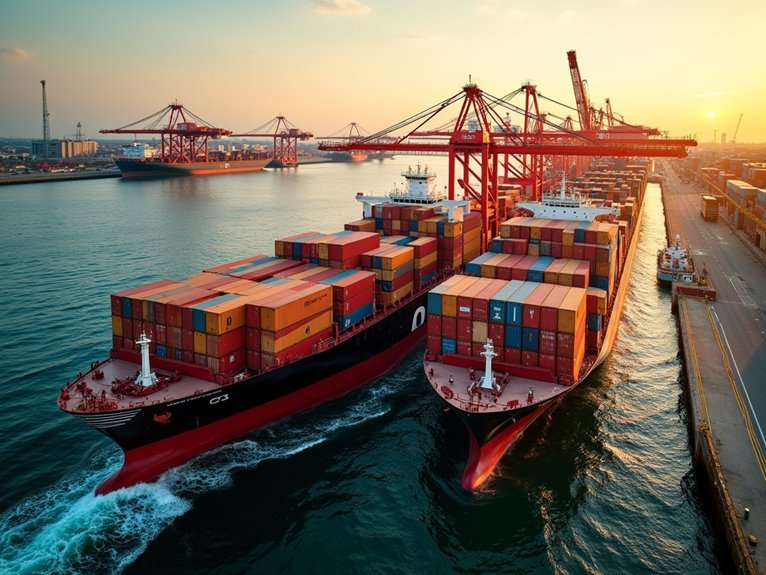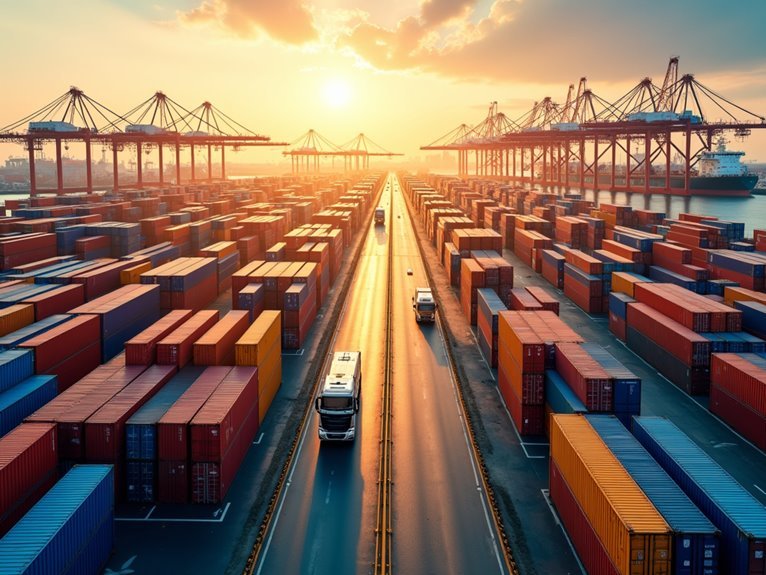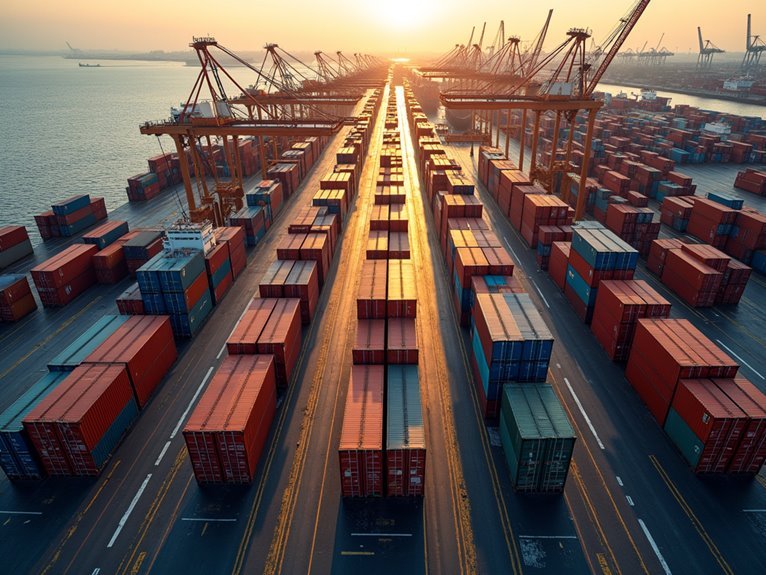Trading blocs are agreements where countries slash tariffs and quotas with each other, creating economic partnerships that benefit members. I’ve identified five main types: preferential trading areas, free trade areas, customs unions, common markets, and economic unions—each with different integration levels. Benefits include cheaper goods, stronger bargaining power, and expanded markets. Major blocs like the EU and ASEAN reshape global trade, though challenges exist. These partnerships now handle over half of world commerce.
Understanding Trading Blocs and Their Purpose

When countries shake hands on trade deals, they’re not just being polite—they’re forming trading blocs. These intergovernmental agreements do the heavy lifting of economic integration. Think of them as exclusive clubs where members get special perks.
I’ll break it down for you. Trading blocs slash tariffs and quotas between member countries. They’re basically saying, “Let’s make business easier for us.” The goal? Create economic interdependence that benefits everyone inside the club.
Trading blocs slash tariffs between members to create economic interdependence that benefits everyone inside the club.
Most blocs focus on regional integration. Makes sense—it’s easier to trade with your neighbor than someone halfway around the world. Transportation costs drop. Communication improves. Members work together on common policies and standards, creating one big unified market. Beyond just reducing barriers, these blocs establish common regulatory standards that streamline how businesses operate across borders. By 1997, more than 50% of global commerce occurred within these regional trade blocs. The World Trade Organisation permits these arrangements, but they must result in lower protection against outside countries after creation.
The endgame is simple: boost trade efficiency, spark economic growth, and muscle up against global competition. It’s economic teamwork at its finest. Or at least, that’s the plan.
Five Main Types of Trading Blocs
Five distinct trading bloc types dominate the global economic landscape, each with its own rulebook and membership perks. Let me break them down for you.
First up: Preferential Trading Areas. Think of PTAs as trade’s shallow end—members cut deals on specific goods but keep their independence. India and Chile’s arrangement covers 1,800 products. Baby steps. PTAs reduce trade barriers on some goods traded between members without eliminating them entirely.
Free Trade Areas go bigger. They’ll axe most tariffs between members while letting everyone set their own external policies. NAFTA (now USMCA) exemplifies this approach. FTAs enable free movement of goods and services without customs duties between member nations.
Customs Unions? Now we’re cooking. Members create a unified front against outsiders with common external tariffs. The EU started here. Benelux stands as a classic example of this common trade policy approach. The Southern African Customs Union demonstrates how five nations can share revenue from their collective tariff system.
Common Markets add muscle—goods, workers, money, and services flow freely. The EU’s single market shows how it’s done.
Economic Unions represent the ultimate merger. They’re aiming for total policy harmony, maybe even shared currency. The GCC’s chasing this dream. It’s ambitious—and politically tricky.
Key Benefits of Trading Bloc Membership

Trading bloc membership delivers concrete economic wins—if you’re willing to play by the rules.
The math is simple. Remove tariffs, watch trade volumes spike. Member countries suddenly find export markets wide open while consumers enjoy cheaper imported goods. Small nations? They punch above their weight class, gaining bargaining power they’d never have alone.
Remove tariffs, watch trade spike. Small nations punch above their weight class.
Here’s where it gets interesting. Companies achieve massive economies of scale across integrated markets. Fixed costs spread thinner. Unit prices drop. Countries specialize in what they do best—comparative advantage in action. Beyond economic gains, security cooperation strengthens as member nations build trust through shared prosperity. Foreign investment pours in because investors can target multiple markets through one entry point. The free movement of labor enables expertise and technology to flow across borders, driving innovation and production improvements throughout the bloc.
The political perks matter too. Economic ties create trust. Member states coordinate policies easier. Rules harmonize. Investment risks shrink. When economic shocks hit, bloc members respond together. War between trading partners? Remarkably rare. The gravity theory confirms what traders always knew—neighboring countries trade more simply because moving goods costs less.
Bottom line: Trading blocs accelerate growth, create jobs, and push less developed members toward prosperity. Not bad for some bureaucratic agreements.
How Trading Blocs Shape the Global Economy
While politicians love to talk about free global trade, the reality is that trading blocs are quietly redrawing the world’s economic map—and the numbers prove it. From 2018 to 2023, a massive $270 billion in trade shifted toward within-bloc partners. That’s not pocket change.
I’ve watched this transformation accelerate. Countries are picking sides—about a quarter align with the US, another quarter with China, and half stay unaligned (smart move, maybe). The pattern’s clear: trade flows between blocs stagnate while intra-bloc exchanges boom. Major blocs like the EU, NAFTA/USMCA, ASEAN, Mercosur, and CPTPP now serve as engines of economic integration, driving high intra-regional trade and increased GDP. The EU alone creates a single market of over 446 million consumers, making it the world’s largest trading bloc.
Here’s what surprises me: despite all this fragmentation, global trade costs stayed stable from 2015 to 2023. No major GDP shocks. Why? Within-bloc gains offset inter-bloc losses. But there’s a hidden cost—fragmentation limits productivity gains by preventing industries from relocating to their most efficient locations globally.
The unaligned countries? They’re actually winning, with 0.8% income increases from trade changes versus 0.6% for aligned nations. Flexibility pays. What’s driving this realignment isn’t just economics—UN voting patterns now predict trade relationships as strongly as traditional economic factors.
Trading blocs aren’t just economic tools anymore—they’re geopolitical weapons shaping tomorrow’s alliances.
Strategic Considerations for Countries

So you’re a country looking at these trading blocs and wondering: should I jump in or stay out?
It’s not a simple yes or no. First, check if your economy even fits. Can you handle bloc regulations? Will your industries complement theirs? Look at your GDP. Your market size. Your existing trade partners—you don’t want to tick them off.
Then there’s politics. Can you stomach giving up some sovereignty? Because that’s the deal. You follow their rules. Your foreign policy needs to align too. No rogue moves.
Sure, you’ll get access to bigger markets. Better supply chains. Less risk. But getting there? That’s expensive. New infrastructure. New regulations. New everything. You’ll need to update your systems to handle the elimination of tariffs that comes with membership.
Timing matters. Jump in early when blocs are expanding—better terms. But watch your back with non-members. You still need them. Without membership, you’ll face common external tariffs when trading with bloc members, putting you at a competitive disadvantage.
Bottom line: It’s chess, not checkers. Think three moves ahead.
Major Challenges Facing Trading Blocs
Even if you’ve joined the perfect trading bloc, here’s the kicker: these things are falling apart at the seams. The US and EU are slapping tariffs on everything that moves. China’s playing hardball. Everyone’s building walls, not bridges.
Trade deficits are exploding. The US-China gap? It’s a canyon now. Meanwhile, BRICS is cooking up its own currency – talk about shaking the table. And don’t get me started on supply chains. One ship gets stuck in a canal, and suddenly nobody can buy a PlayStation. Maritime traffic through the Suez Canal plummeted by over 50% in late 2024, showing just how fragile these routes really are.
Here’s where it gets messy: climate goals clash with trade rules. Europe wants green standards; others cry foul. Data regulations? A nightmare. Every bloc has different rules about where your info can travel. The WTO reports trade-restrictive measures affecting USD887.7 billion in global commerce, signaling an alarming shift toward protectionism.
The real punch in the gut? Infrastructure gaps. Some countries have bullet trains; others have dirt roads. Try integrating that. Political tensions make everything worse – one tweet can tank a trade deal. And while developing economies are driving growth, they’re getting squeezed out by the big players hoarding all the benefits.
Examples of Successful Trading Blocs Worldwide
Despite all the doom and gloom, some trading blocs are actually crushing it. Let’s look at the heavy hitters.
The EU’s been at this game longest—27 countries operating as one massive market. Sure, Brexit was messy, but they’re still pulling in 14% of global trade.
RCEP’s the new kid who showed up and immediately dominated. Launched in 2022, it connects Asia’s biggest economies for the first time. That’s 30% of global GDP right there.
| Trading Bloc | Population | Key Achievement |
|---|---|---|
| RCEP | 2.3 billion | First deal linking China, Japan, S. Korea |
| EU | 447 million | Single market with free movement |
| AfCFTA | 1.3 billion | Could boost intra-African trade by 52% |
AfCFTA’s the dark horse. Launched in 2020, it’s already Africa’s moonshot—potentially lifting 50 million people out of poverty by 2035. Meanwhile, the GCC’s six nations have built their own powerhouse in the Middle East, leveraging oil wealth for deeper economic integration. With 330 regional trade agreements now active globally, these mega-blocs are setting the pace for how modern economies integrate.
These aren’t just trade deals. They’re reshaping entire continents.



